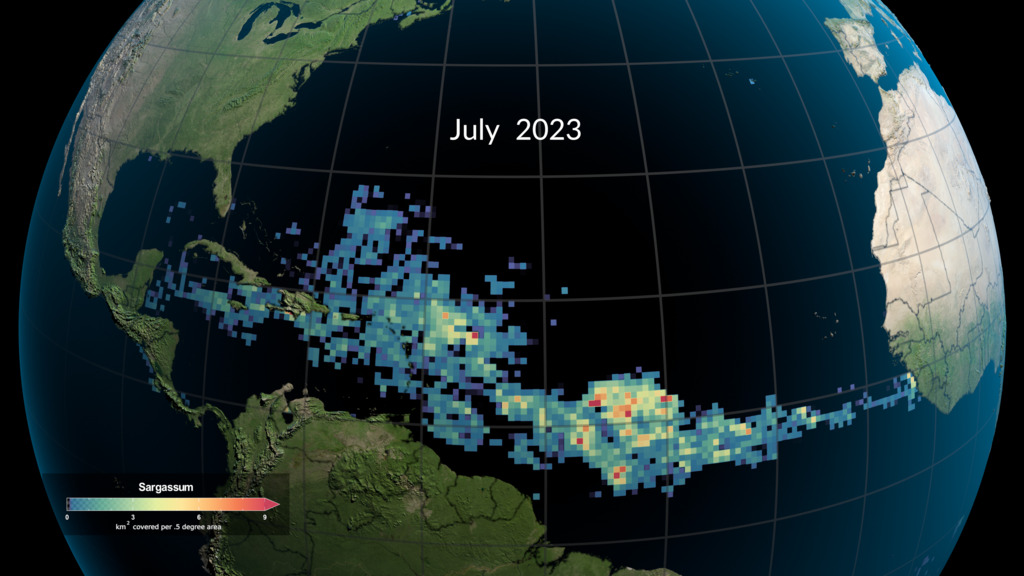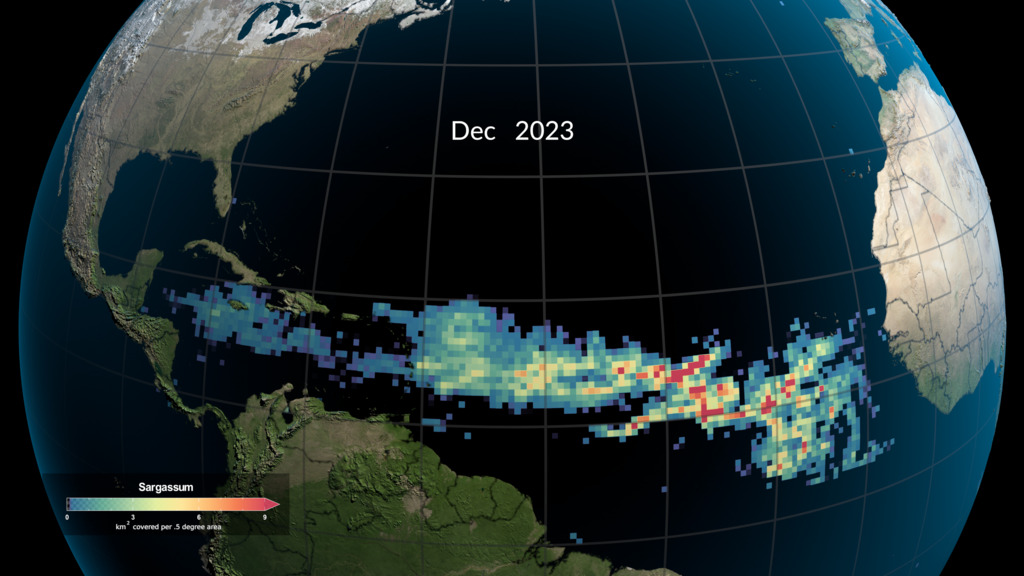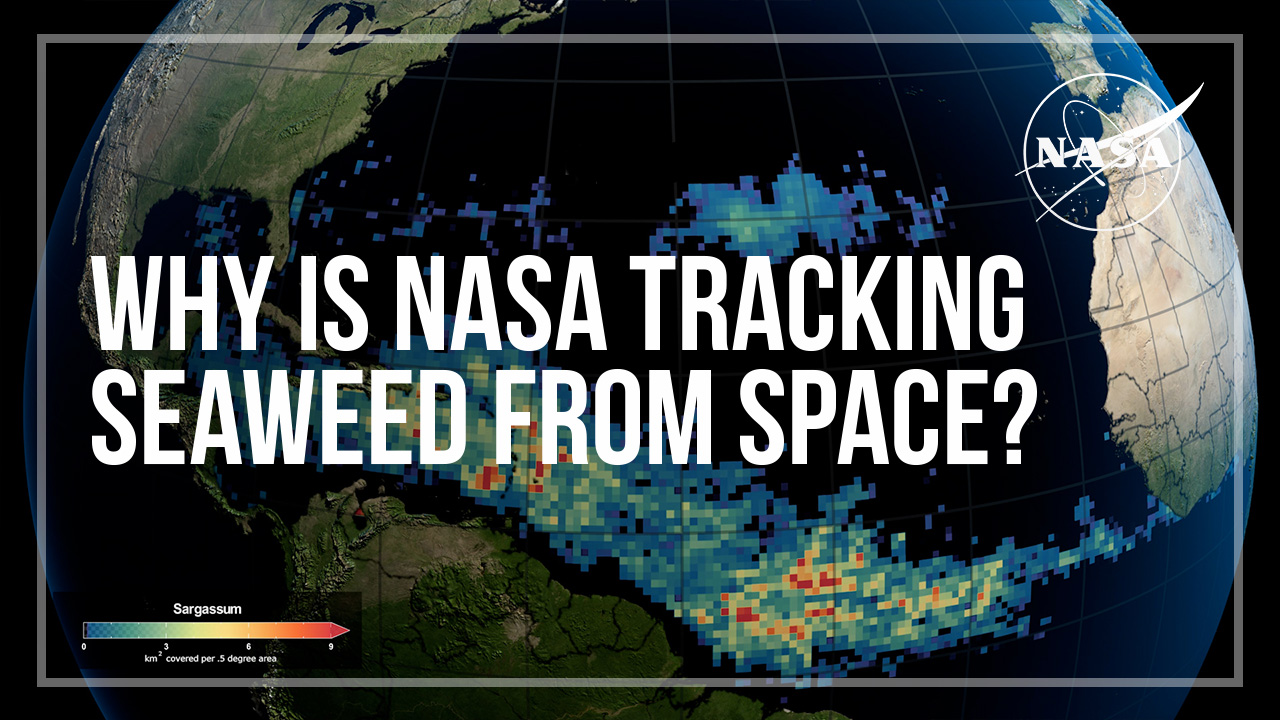Atlantic Ocean Surface Drift Patterns from the Caribbean in 2010 and 2011
Simulated particle backtrack with windage and timeline
This visualization shows simulated particles released during 2010 and 2011 traced back in time to show their path based on the ocean surface velocities from Global HYCOM model with 1% windage applied. Simulated particles were released between December through April and tracked back in time. The gold balls under the timeline indicate the months when particles were released. Flow lines represent the movement of a particle over a 20-day period. Particles that venture above the 23 degree north latitude line (shown in red) during their lifespan are colored gold while particles that stayed south of it are colored green.
The islands in the Caribbean have long been known for their crystal clear water and white sand beaches. But in the spring of 2011, something unusual occurred. Thousands of tons of brown alga, known as Sargassum, started washing up on beaches around the Caribbean. Sargassum has historically been found primarily in the Gulf of Mexico and in the North Atlantic Ocean bound by a spiral of currents including the Gulf Stream, the North Atlantic Current, the Canary Current and the North Atlantic Equatorial Current.
After extensive analysis, researchers found that in the winter of 2009 – 2010 unusually strong westerly winds in the Atlantic Ocean caused some of the floating Sargassum to be pushed from the middle Atlantic Ocean towards Gibraltar where ocean currents eventually carried it south down the coast of Africa and back across the Atlantic Ocean towards the Caribbean. With the exception of 2013, the Sargassum has continued to wash up on Caribbean beaches every year since 2011. The Sargassum has flourished in the warm equatorial waters, being nourished by upwelling and by the dust from Africa as well as by the nutrient-rich discharge from the Amazon and Orinoco rivers in South America.
These visualizations show the transport of simulated particles dropped at random locations in the Caribbean and traced backward in time based on model data provided by Nathan Putman. He used the ocean surface velocities from Global HYCOM model for ocean currents along with a 1% windage factor derived from NCEP Reanalysis surface wind data to trace these particles back in time. Two differet versions of this visualization is shown: one using the ocean surface velocities with the windage factor applied and another that only uses only the ocean surface velocities.
Synthetic particles were released at random locations in the Caribbean every 5 days from December through April and tracked back in time. We show the data released in 2010, the year before the Sargassum arrived in the Caribbean followed by data released in 2011, the first year that it accumulated in the region. The gold balls shown under the timeline indicate the months when particles were released. Each flow line represents movement of a particle over a 20-day time period. The color of the lines indicates the maximum latitude that the particle reached in its simulated lifespan. Particles that venture above the 23 degree north latitude line (shown in red) during their lifespan are colored gold while particles that stayed south of it are colored green.
Simulated particle backtrack without windage with timeline
This visualization shows simulated particles released during 2010 and 2011 traced back in time to show their path based on the ocean surface velocities from Global HYCOM model but without any influence from the surface winds. Simulated particles were released between December through April and tracked back in time. The gold balls under the timeline indicate the months when particles were released. Flow lines represent the movement of a particle over a 20-day period. Particles that venture above the 23 degree north latitude line (shown in red) during their lifespan are colored gold while particles that stayed south of it are colored green.
Simulated particle backtrack with windage without timeline
This visualization shows the above particle visualization based on ocean surface velocities with influence from surface winds and without the animated time line. Either of the time lines available below can be composited over this with a 1 - 1 frame match.
Simulated particle backtrack without windage and timeline
This visualization shows the above particle visualization based on ocean surface velocities without influence from surface winds and without the animated time line. Either of the time lines available below can be composited over this with a 1 - 1 frame match.

Timeline
The simple animated timeline for the simulated particle backtrack visualizations with transparency. This timeline does not indicate the months when particles were released.

Timeline with particle releases indicated
The animated timeline for the simulated particle backtrack visualizations with transparency. The gold balls under the timeline indicate the months when particles were released.
Credits
Please give credit for this item to:
NASA's Scientific Visualization Studio
-
Visualizers
- Cindy Starr (Global Science and Technology, Inc.)
- Greg Shirah (NASA/GSFC)
- Atousa Saberi (NASA/GSFC)
-
Scientists
- Nathan F Putman (LGL Ecological Research Associates, Inc)
- Roy Armstrong (University of Puerto Rico)
-
Producers
- Katie Jepson (eMITS)
- Jefferson Beck (eMITS)
-
Technical support
- Laurence Schuler (ADNET Systems, Inc.)
- Ian Jones (ADNET Systems, Inc.)
Release date
This page was originally published on Monday, September 30, 2024.
This page was last updated on Monday, January 6, 2025 at 1:13 AM EST.
Related papers
Johns, E. M. et al. The establishment of a pelagic Sargassum population in the tropical Atlantic: biological consequences of a basin-scale long distance dispersal event. Prog. Oceanogr. 182, 102269 (2020).
Putman, N.F., Goni, G.J., Gramer, L.J., Hu, C., Johns, E.M., Trinanes, J., Wang, M., 2018. Simulating transport pathways of Sargassum from the Equatorial Atlantic into the Caribbean Sea. Prog. Oceanogr. 165, 205–214.
Datasets used
-
Drift patterns using surface currents from global HYCOM model with 1% windage from NCEP reanalysis winds
ID: 1221Credit: Nathan F. Putman,
See all pages that use this dataset -
Drift patterns using surface currents from global HYCOM model
ID: 1222Credit: Nathan F. Putman,
See all pages that use this dataset
Note: While we identify the data sets used on this page, we do not store any further details, nor the data sets themselves on our site.



